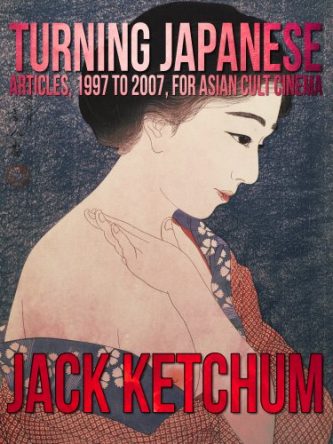 By JACK KETCHUM (Crossroad Press; 2013)
By JACK KETCHUM (Crossroad Press; 2013)
A short collection of six Asian Cult Cinema magazine articles, spanning the years 1997 to 2007, by the late horror novelist Jack Ketchum. The subject is extreme cinema from Japan, of which Ketchum (an author whose fiction pretty much defined extreme) had a thorough knowledge. As he states early on, “no artist working seriously on the subject in any medium should be worrying for one minute about good taste or offending your sorry ass or mine.” (For the easily offended among you, that quote should serve as a fair warning that what’s about to follow is probably not to your taste.)
A brief introduction states that Ketchum was contacted by ACC’s editor Thomas Weisser to write for the mag, claiming that Ketchum and director Katsuya Matsumura would be a “good pairing.” The resulting article, “That Smile, The Films of Katsuya Matsumura,” is the first to be reprinted here.
The article is suitably Ketchum-esque, drafted in ultra-terse prose in which single sentence paragraphs predominate. Examined is Matsuura’s ALL NIGHT LONG trilogy, a grungy shot-on-video triumvirate about which Ketchum promises “these three films mean to hurt you. They’re scary.” I don’t quite agree with the oft-overwrought superlatives he lavishes on them (“In some ways they’re beautiful, rich, with wonderful long silences, eerie music, fine disturbing camera angles and serious, true, sometimes almost delicate performances”), but can’t deny that he makes some compelling points.
Next up is “Blood Wedding: On Yasuharu Hasebe’s ASSAULT! JACK THE RIPPER.” The 1976 film in question is one of the most notorious Japanese exploitation pics of all time, but Ketchum finds a great deal to admire about it, proclaiming “What could easily have been just another cheapjack sex-and-body-count flick is instead a nasty, wacky but emotionally true take on questions of bonding, empowerment and ultimately, freedom.”
“No Way Back: The Ran Masaki Films” pays tribute to the prolific Pinku eiga actress Ran Masaki, the star of exploiters like WHITE UNIFORM ROPE SLAVE, BEAUTIFUL TEACHER IN TORTURE HELL and SNAKE AND WHIP (titles that, as Ketchum eagerly points out, are “wholly willing, more often than not, to tell you exactly what you’re about to see”). “Quiet on the Set” examines Takashi Miike’s notorious over-the-toppers AUDITION and VISITOR Q, films that apparently “linger in the memory as powerfully and quietly as poisoned air.”
“FLOWER AND SNAKE–Find the Flower” is about the 2004 Takashi Ishii remake of 1974’s FLOWER AND SNAKE. Both are examined, with Ketchum ultimately coming out in favor of Ishii’s film—and even, unlikely enough, proclaiming it a feminist statement. “FLOWER AND SNAKE 2: A Dialogue” concludes the book. It consists of a (fictional?) convo between Ketchum and an unnamed female acquaintance about FLOWER AND SNAKE 2, with Ketchum once again finding a feminist conscience contained therein—but concluding with “What the hell do I know?”
